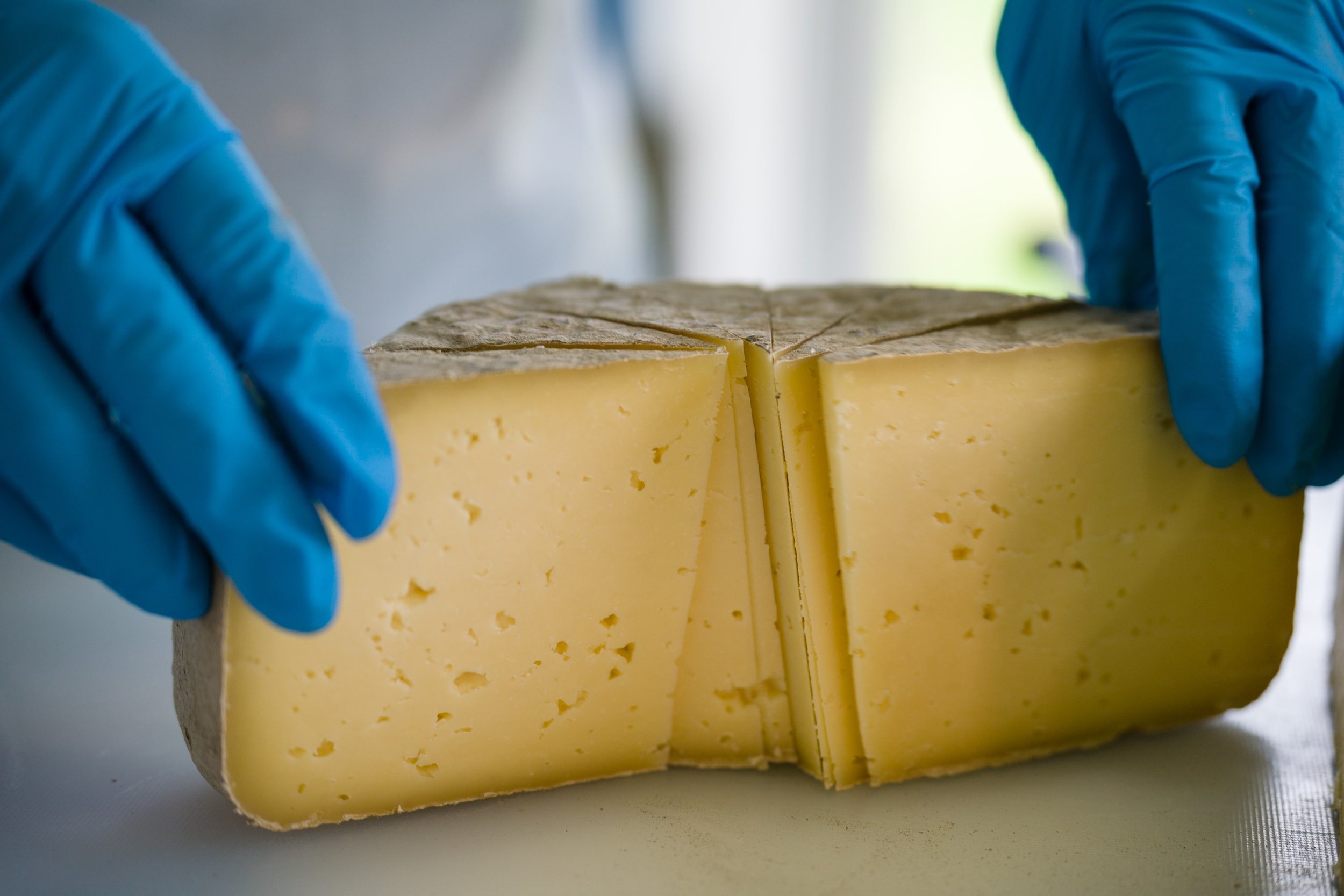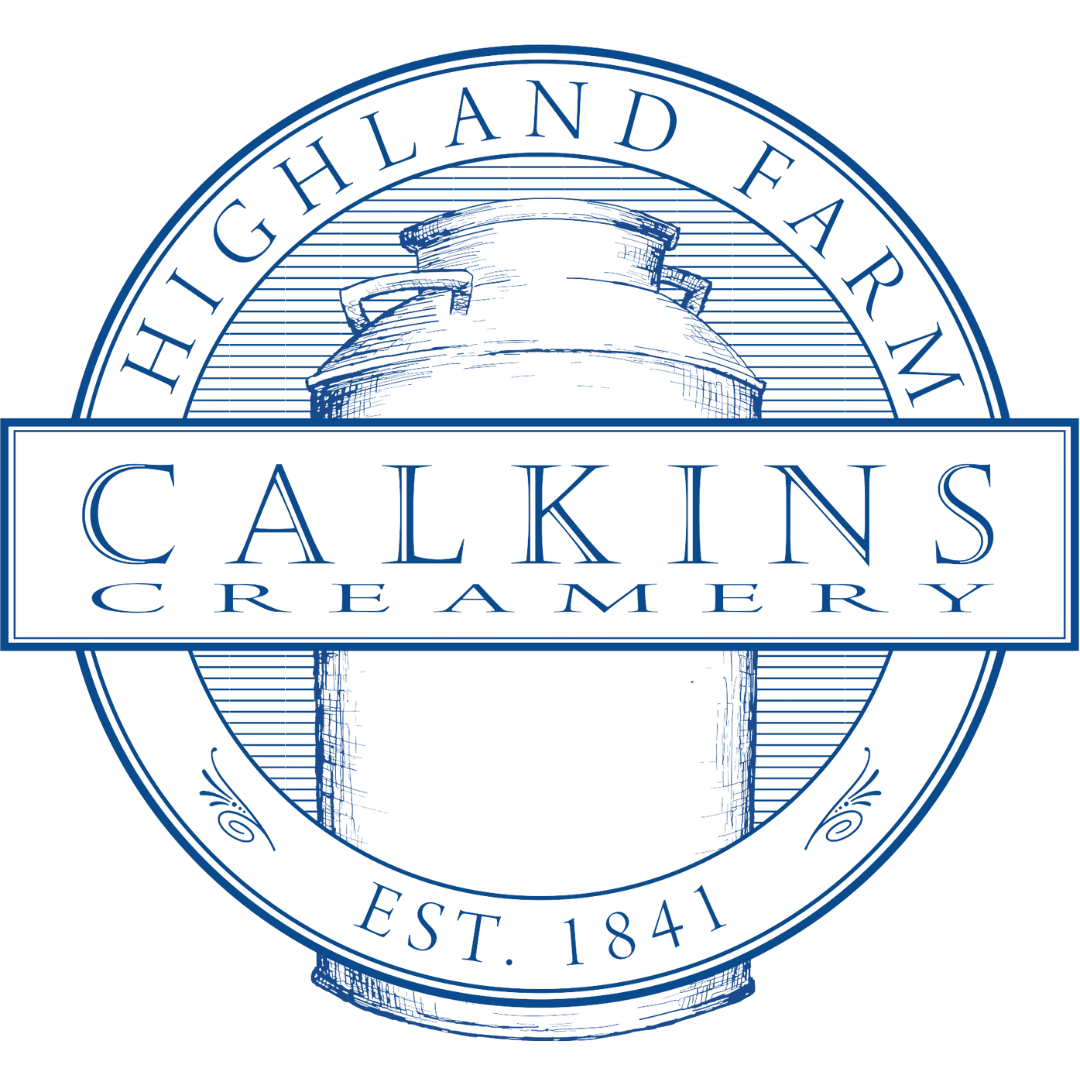
OUR CHEESEMAKING PROCESS
“Calkins Creamery specializes in fine, artisan cheeses, using only the freshest milk possible from our very own herd of registered Holstein cattle. Our cows are well cared for and comfortable, as cow comfort reduces stress and increases milk production and butterfat."
- Emily Montgomery, Owner & CheesemakerIt All Begins with Milk from Our Happy Herd of Holstein Cows
Loving care goes into every cheese we make at Calkins Creamery, and it all begins with milk from our happy Holstein cows.
Milk is drawn into our cheese vats early in the morning when the farmers begin milking the cows on our family farm.
Our cheesemaker hooks up the sanitized pipes to the milk tank in the barn and pumps the milk into the cheese vats. The stainless steel transfer pipes are underground and allow us to transfer the milk to the Creamery in a sterile closed circuit, avoiding contamination along the way. The milk is then filtered as it is pumped into the cheese vat.
Then the Milk Begins the Process of Becoming Cheese
We have two vats we use in our facility. Our cheese vat is used to produce raw milk cheese. This means that the milk undergoes no heat treatment, and the cheese, by law, needs to be aged in our facility under set guidelines for a minimum of 60 days.
Our second vat is a vat pasteurizer. This vat makes pasteurized cheeses that can be sold as soon as the cheese has reached its ideal ripening time (no requirement by law to hold the cheese a set number of days). Pasteurization is a heat treatment process that kills any bacteria found in raw milk.
Regardless of whether the milk is pasteurized, the cheesemaking process begins with heating the milk to a set temperature for the addition of the cultures.
Good bacteria or “starter cultures” are added to the milk. These starter cultures ferment the lactose (milk’s natural sugar) into lactic acid. The process helps determine the cheese’s flavor and texture.
We use different cultures to create different types of cheese. For example, Gouda uses one type of culture, while Brie and Cheddar use others. Starter culture generally needs 30 minutes to an hour to work its magic on lactose.
Then We Cut the Curds
Rennet, which causes the milk to gel in a way similar to yogurt or jello, is then added to the vat. The amount of rennet and time needed for the milk to coagulate can vary from cheese to cheese.
Once the milk has gelled into a curd mass, that mass is cut with stainless steel wire knives, creating half-inch cubes. The curds (the solids) separate from the whey (the liquid). Drier cheeses are often cut more to form smaller curds, so more moisture comes out, while moister cheeses are formed from curds cut less and left larger.
Once the curds are cut, they’re stirred and heated to release even more whey. And when the curd has reached its optimal shape and pH, we settle the curds on the bottom of the vat.
At this point, the curd is drained and separated from the whey. Then the curd is transferred into cheese molds lined with cheesecloth. Once the molds are filled, the cheese is stacked on the press, and pressure is applied. While the cheese is pressed, more whey comes out, creating the cheese consistency we believe is ideal for each variety of cheese.
And the Last Step — Giving Each Cheese What It Needs to Taste Its Best
Now it’s time for the salt.
There are several methods for adding salt to the cheese. The first way is to add salt to the curd in the vat before hooping the cheese into cheese molds. The second approach is to press the cheese in the cheese mold, and after reaching the correct shape and pH, the cheese wheel is added to a brine tank where it will slowly absorb the salt. The last approach is to apply salt to the outside of the wheel after it is formed into a wheel and the desired pH is reached.
Salt is a key ingredient because it keeps the pH at the ideal range by stopping the bacteria from working. Before the cheese is hooped, seasonings are added and mixed into the cheese curds by hand.
Once the cheese is shaped and pressed, it is aged according to each cheese’s formulation recipe.
From there, it’s packaged and ready for you to enjoy!
About Our Cheese Cave
We expanded our business early on when we rented space in a wine cave owned by Calkins Creek Vineyard. The owner, Mike Stone, designed and built the underground cave for aging his wine. We discovered the cave was a perfect environment for aging our natural rind cheeses. The temperature and humidity are monitored daily to ensure the aging requirements are kept in an ideal range.
Later, Mike sold the property to Second District Brew Farm.
We continue to age our cheese at the cave and have become great partners with Second District. They have a fabulous tasting room at their brewery featuring our cheese — be sure to check it out.









